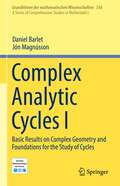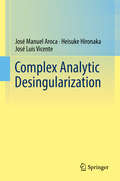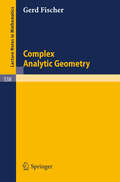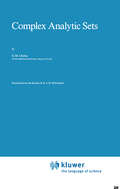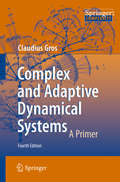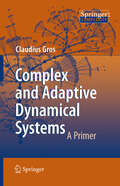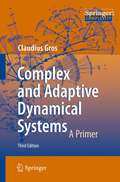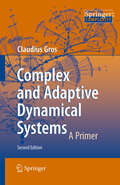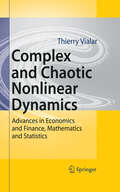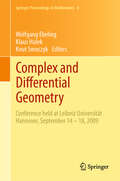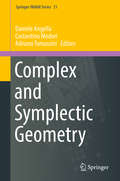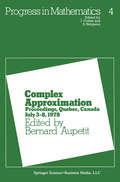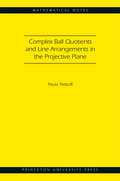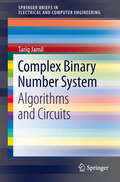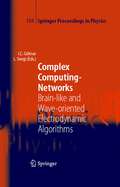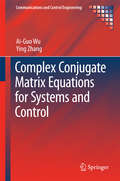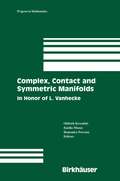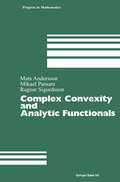- Table View
- List View
Complex Analytic Cycles I: Basic Results on Complex Geometry and Foundations for the Study of Cycles (Grundlehren der mathematischen Wissenschaften #356)
by Daniel Barlet Jón MagnússonThe book consists of a presentation from scratch of cycle space methodology in complex geometry. Applications in various contexts are given. A significant portion of the book is devoted to material which is important in the general area of complex analysis. In this regard, a geometric approach is used to obtain fundamental results such as the local parameterization theorem, Lelong' s Theorem and Remmert's direct image theorem. Methods involving cycle spaces have been used in complex geometry for some forty years. The purpose of the book is to systematically explain these methods in a way which is accessible to graduate students in mathematics as well as to research mathematicians. After the background material which is presented in the initial chapters, families of cycles are treated in the last most important part of the book. Their topological aspects are developed in a systematic way and some basic, important applications of analytic families of cycles are given. The construction of the cycle space as a complex space, along with numerous important applications, is given in the second volume. The present book is a translation of the French version that was published in 2014 by the French Mathematical Society.
Complex Analytic Desingularization
by José Manuel Aroca Heisuke Hironaka José Luis Vicente[From the foreword by B. Teissier] The main ideas of the proof of resolution of singularities of complex-analytic spaces presented here were developed by Heisuke Hironaka in the late 1960s and early 1970s. Since then, a number of proofs, all inspired by Hironaka's general approach, have appeared, the validity of some of them extending beyond the complex analytic case. The proof has now been so streamlined that, although it was seen 50 years ago as one of the most difficult proofs produced by mathematics, it can now be the subject of an advanced university course. Yet, far from being of historical interest only, this long-awaited book will be very rewarding for any mathematician interested in singularity theory. Rather than a proof of a canonical or algorithmic resolution of singularities, what is presented is in fact a masterly study of the infinitely near “worst” singular points of a complex analytic space obtained by successive “permissible” blowing ups and of the way to tame them using certain subspaces of the ambient space. This taming proves by an induction on the dimension that there exist finite sequences of permissible blowing ups at the end of which the worst infinitely near points have disappeared, and this is essentially enough to obtain resolution of singularities. Hironaka’s ideas for resolution of singularities appear here in a purified and geometric form, in part because of the need to overcome the globalization problems appearing in complex analytic geometry.In addition, the book contains an elegant presentation of all the prerequisites of complex analytic geometry, including basic definitions and theorems needed to follow the development of ideas and proofs. Its epilogue presents the use of similar ideas in the resolution of singularities of complex analytic foliations. This text will be particularly useful and interesting for readers of the younger generation who wish to understand one of the most fundamental results in algebraic and analytic geometry and invent possible extensions and applications of the methods created to prove it.
Complex Analytic Sets (Mathematics and its Applications #46)
by E.M. ChirkaThe theory of complex analytic sets is part of the modern geometrical theory of functions of several complex variables. A wide circle of problems in multidimensional complex analysis, related to holomorphic functions and maps, can be reformulated in terms of analytic sets. In these reformulations additional phenomena may emerge, while for the proofs new methods are necessary. (As an example we can mention the boundary properties of conformal maps of domains in the plane, which may be studied by means of the boundary properties of the graphs of such maps.)The theory of complex analytic sets is a relatively young branch of complex analysis. Basically, it was developed to fulfill the need of the theory of functions of several complex variables, but for a long time its development was, so to speak, within the framework of algebraic geometry - by analogy with algebraic sets. And although at present the basic methods of the theory of analytic sets are related with analysis and geometry, the foundations of the theory are expounded in the purely algebraic language of ideals in commutative algebras.In the present book I have tried to eliminate this noncorrespondence and to give a geometric exposition of the foundations of the theory of complex analytic sets, using only classical complex analysis and a minimum of algebra (well-known properties of polynomials of one variable). Moreover, it must of course be taken into consideration that algebraic geometry is one of the most important domains of application of the theory of analytic sets, and hence a lot of attention is given in the present book to algebraic sets.
Complex and Adaptive Dynamical Systems: A Primer (Springer Complexity Ser.)
by Claudius GrosThis primer offers readers an introduction to the central concepts that form our modern understanding of complex and emergent behavior, together with detailed coverage of accompanying mathematical methods. All calculations are presented step by step and are easy to follow. This new fourth edition has been fully reorganized and includes new chapters, figures and exercises. The core aspects of modern complex system sciences are presented in the first chapters, covering network theory, dynamical systems, bifurcation and catastrophe theory, chaos and adaptive processes, together with the principle of self-organization in reaction-diffusion systems and social animals. Modern information theoretical principles are treated in further chapters, together with the concept of self-organized criticality, gene regulation networks, hypercycles and coevolutionary avalanches, synchronization phenomena, absorbing phase transitions and the cognitive system approach to the brain. Technical course prerequisites are the standard mathematical tools for an advanced undergraduate course in the natural sciences or engineering. Each chapter includes exercises and suggestions for further reading, and the solutions to all exercises are provided in the last chapter.From the reviews of previous editions: This is a very interesting introductory book written for a broad audience of graduate students in natural sciences and engineering. It can be equally well used both for teaching and self-education. Very well structured and every topic is illustrated with simple and motivating examples. This is a true guidebook to the world of complex nonlinear phenomena. (Ilya Pavlyukevich, Zentralblatt MATH, Vol. 1146, 2008)Claudius Gros’ Complex and Adaptive Dynamical Systems: A Primer is a welcome addition to the literature. A particular strength of the book is its emphasis on analytical techniques for studying complex systems. (David P. Feldman, Physics Today, July, 2009).
Complex and Adaptive Dynamical Systems: A Primer
by Claudius GrosHelping us understand our complex world, this book presents key findings in quantitative complex system science. Its approach is modular and phenomenology driven. Examples of phenomena treated in the book include the small world phenomenon in social and scale-free networks; life at the edge of chaos; the concept of living dynamical systems; and emotional diffusive control within cognitive system theory. Each chapter includes exercises to test your grasp of new material. Written at an introductory level, the author provides an accessible entry for graduate students in physics, mathematics, and theoretical computer science.
Complex and Adaptive Dynamical Systems: A Primer
by Claudius GrosComplex system theory is rapidly developing and gaining importance, providing tools and concepts central to our modern understanding of emergent phenomena. This primer offers an introduction to this area together with detailed coverage of the mathematics involved.All calculations are presented step by step and are straightforward to follow. This new third edition comes with new material, figures and exercises.Network theory, dynamical systems and information theory, the core of modern complex system sciences, are developed in the first three chapters, covering basic concepts and phenomena like small-world networks, bifurcation theory and information entropy.Further chapters use a modular approach to address the most important concepts in complex system sciences, with the emergence and self-organization playing a central role. Prominent examples are self-organized criticality in adaptive systems, life at the edge of chaos, hypercycles and coevolutionary avalanches, synchronization phenomena, absorbing phase transitions and the cognitive system approach to the brain.Technical course prerequisites are the standard mathematical tools for an advanced undergraduate course in the natural sciences or engineering. Each chapter comes with exercises and suggestions for further reading - solutions to the exercises are provided in the last chapter.From the reviews of previous editions:This is a very interesting introductory book written for a broad audience of graduate students in natural sciences and engineering. It can be equally well used both for teaching and self-education. Very well structured and every topic is illustrated by simple and motivating examples. This is a true guidebook to the world of complex nonlinear phenomena. (Ilya Pavlyukevich, Zentralblatt MATH, Vol. 1146, 2008)"Claudius Gros's Complex and Adaptive Dynamical Systems: A Primer is a welcome addition to the literature. . A particular strength of the book is its emphasis on analytical techniques for studying complex systems. (David P. Feldman, Physics Today, July, 2009)
Complex and Adaptive Dynamical Systems: A Primer
by Claudius GrosDiscover a wide range of findings in quantitative complex system science that help us make sense of our complex world. Written at an introductory level, the book provides an accessible entry into this fascinating and vitally important subject.
Complex and Chaotic Nonlinear Dynamics: Advances in Economics and Finance, Mathematics and Statistics
by Thierry VialarComplex dynamics constitute a growing and increasingly important area as they offer a strong potential to explain and formalize natural, physical, financial and economic phenomena. This book pursues the ambitious goal to bring together an extensive body of knowledge regarding complex dynamics from various academic disciplines. Beyond its focus on economics and finance, including for instance the evolution of macroeconomic growth models towards nonlinear structures as well as signal processing applications to stock markets, fundamental parts of the book are devoted to the use of nonlinear dynamics in mathematics, statistics, signal theory and processing. Numerous examples and applications, almost 700 illustrations and numerical simulations based on the use of Matlab make the book an essential reference for researchers and students from many different disciplines who are interested in the nonlinear field. An appendix recapitulates the basic mathematical concepts required to use the book.
Complex and Differential Geometry: Conference held at Leibniz Universität Hannover, September 14 – 18, 2009 (Springer Proceedings in Mathematics #8)
by Wolfgang Ebeling Klaus Hulek Knut SmoczykThis volume contains the Proceedings of the conference "Complex and Differential Geometry 2009", held at Leibniz Universität Hannover, September 14 - 18, 2009. It was the aim of this conference to bring specialists from differential geometry and (complex) algebraic geometry together and to discuss new developments in and the interaction between these fields. Correspondingly, the articles in this book cover a wide area of topics, ranging from topics in (classical) algebraic geometry through complex geometry, including (holomorphic) symplectic and poisson geometry, to differential geometry (with an emphasis on curvature flows) and topology.
Complex and Symplectic Geometry (Springer INdAM Series #21)
by Daniele Angella Costantino Medori Adriano TomassiniThis book arises from the INdAM Meeting "Complex and Symplectic Geometry", which was held in Cortona in June 2016. Several leading specialists, including young researchers, in the field of complex and symplectic geometry, present the state of the art of their research on topics such as the cohomology of complex manifolds; analytic techniques in Kähler and non-Kähler geometry; almost-complex and symplectic structures; special structures on complex manifolds; and deformations of complex objects. The work is intended for researchers in these areas.
Complex Approximation: Proceedings, Quebec, Canada July 3–8, 1978 (pdf) (Progress in Mathematics #4)
by B. AupetitComplex Ball Quotients and Line Arrangements in the Projective Plane (MN-51)
by Paula Tretkoff Hans-Christoph Im HofThis book introduces the theory of complex surfaces through a comprehensive look at finite covers of the projective plane branched along line arrangements. Paula Tretkoff emphasizes those finite covers that are free quotients of the complex two-dimensional ball. Tretkoff also includes background on the classical Gauss hypergeometric function of one variable, and a chapter on the Appell two-variable F1 hypergeometric function.The material in this book began as a set of lecture notes, taken by Tretkoff, of a course given by Friedrich Hirzebruch at ETH Zürich in 1996. The lecture notes were then considerably expanded by Hirzebruch and Tretkoff over a number of years. In this book, Tretkoff has expanded those notes even further, still stressing examples offered by finite covers of line arrangements. The book is largely self-contained and foundational material is introduced and explained as needed, but not treated in full detail. References to omitted material are provided for interested readers.Aimed at graduate students and researchers, this is an accessible account of a highly informative area of complex geometry.
Complex Ball Quotients and Line Arrangements in the Projective Plane (MN-51) (PDF)
by Paula Tretkoff Hans-Christoph Im HofThis book introduces the theory of complex surfaces through a comprehensive look at finite covers of the projective plane branched along line arrangements. Paula Tretkoff emphasizes those finite covers that are free quotients of the complex two-dimensional ball. Tretkoff also includes background on the classical Gauss hypergeometric function of one variable, and a chapter on the Appell two-variable F1 hypergeometric function.The material in this book began as a set of lecture notes, taken by Tretkoff, of a course given by Friedrich Hirzebruch at ETH Zürich in 1996. The lecture notes were then considerably expanded by Hirzebruch and Tretkoff over a number of years. In this book, Tretkoff has expanded those notes even further, still stressing examples offered by finite covers of line arrangements. The book is largely self-contained and foundational material is introduced and explained as needed, but not treated in full detail. References to omitted material are provided for interested readers.Aimed at graduate students and researchers, this is an accessible account of a highly informative area of complex geometry.
Complex Binary Number System: Algorithms and Circuits (SpringerBriefs in Electrical and Computer Engineering)
by Tariq JamilThis book is a compilation of the entire research work on the topic of Complex Binary Number System (CBNS) carried out by the author as the principal investigator and members of his research groups at various universities during the years 2000-2012. Pursuant to these efforts spanning several years, the realization of CBNS as a viable alternative to represent complex numbers in an “all-in-one” binary number format has become possible and efforts are underway to build computer hardware based on this unique number system. It is hoped that this work will be of interest to anyone involved in computer arithmetic and digital logic design and kindle renewed enthusiasm among the engineers working in the areas of digital signal and image processing for developing newer and efficient algorithms and techniques incorporating CBNS.
Complex compass bearings 2 (large print)
by New College WorcesterThese nine pages each show an image of compass bearings. There is a locator dot shown, which will be at the top left of the page when the image is the correct way up. On each diagram there are various locations labelled with a capital letter or a town name. There are also north bearings. There are other lines linking the locations with some angles marked in degrees.
Complex compass bearings 2 (UEB contracted)
by New College WorcesterThese nine pages each show an image of compass bearings. There is a locator dot shown, which will be at the top left of the page when the image is the correct way up. On each diagram there are various locations labelled with a capital letter or a town name. There are also north bearings. There are other lines linking the locations with some angles marked in degrees.
Complex compass bearings 2 (UEB uncontracted)
by New College WorcesterThese nine pages each show an image of compass bearings. There is a locator dot shown, which will be at the top left of the page when the image is the correct way up. On each diagram there are various locations labelled with a capital letter or a town name. There are also north bearings. There are other lines linking the locations with some angles marked in degrees.
Complex compass bearings (large print)
by New College WorcesterThese ten pages each show an image of two compass bearings. There is a locator dot shown, which will be at the top left of the page when the image is the correct way up. There are two locations each with a north bearing. The bearing between the two locations is marked with one angle marked in degrees.
Complex compass bearings (UEB contracted)
by New College WorcesterThese ten pages each show an image of two compass bearings. There is a locator dot shown, which will be at the top left of the page when the image is the correct way up. There are two locations each with a north bearing. The bearing between the two locations is marked with one angle marked in degrees.
Complex compass bearings (UEB uncontracted)
by New College WorcesterThese ten pages each show an image of two compass bearings. There is a locator dot shown, which will be at the top left of the page when the image is the correct way up. There are two locations each with a north bearing. The bearing between the two locations is marked with one angle marked in degrees.
Complex Computing-Networks: Brain-like and Wave-oriented Electrodynamic Algorithms (Springer Proceedings in Physics #104)
by Izzet Göknar Levent SevgiThis book contains the ceremonials and the proceedings pertaining to the Int- national Symposium CCN2005 on “Complex Computing-Networks: A Link between Brain-like and Wave-Oriented Electrodynamics Algorithms,” convened at Do ?u ? University of Istanbul, Turkey, on 13–14 June 2005, in connection with the bestowal of the honorary doctorate degrees on Professors Leopold B. Felsen and Leon O. Chua, for their extraordinary achievements in electromagnetics, and n- linear systems, respectively. The symposium was co-organized by Cem Göknar and Levent Sevgi, in consultation with Leopold B. Felsen and Leon O. Chua. Istanbul is a city with wonderful natural and historical surroundings, a city not only interconnecting Asia and Europe but also Eastern and Western cultures. Therefore, CCN2005 was a memorable event not only in the lifetime of Drs. Felsen, Chua, and their families, but also for all the other participants who were there to congratulate the recipients and participate in the symposium.
Complex Conjugate Matrix Equations for Systems and Control (Communications and Control Engineering)
by Ai-Guo Wu Ying ZhangThe book is the first book on complex matrix equations including the conjugate of unknown matrices. The study of these conjugate matrix equations is motivated by the investigations on stabilization and model reference tracking control for discrete-time antilinear systems, which are a particular kind of complex system with structure constraints. It proposes useful approaches to obtain iterative solutions or explicit solutions for several types of complex conjugate matrix equation. It observes that there are some significant differences between the real/complex matrix equations and the complex conjugate matrix equations. For example, the solvability of a real Sylvester matrix equation can be characterized by matrix similarity; however, the solvability of the con-Sylvester matrix equation in complex conjugate form is related to the concept of con-similarity. In addition, the new concept of conjugate product for complex polynomial matrices is also proposed in order to establish a unified approach for solving a type of complex matrix equation.
Complex, Contact and Symmetric Manifolds: In Honor of L. Vanhecke (Progress in Mathematics #234)
by Oldrich Kowalski Emilio E. Musso Domenico Perrone* Contains research and survey articles by well known and respected mathematicians on recent developments and research trends in differential geometry and topology * Dedicated in honor of Lieven Vanhecke, as a tribute to his many fruitful and inspiring contributions to these fields * Papers include all necessary introductory and contextual material to appeal to non-specialists, as well as researchers and differential geometers
Complex Convexity and Analytic Functionals (Progress in Mathematics #225)
by Mats Andersson Mikael Passare Ragnar SigurdssonThis book puts the modern theory of complex linear convexity on a solid footing, and gives a thorough and up-to-date survey of its current status. Applications include the Fantappié transformation of analytic functionals, integral representation formulas, polynomial interpolation, and solutions to linear partial differential equations.
